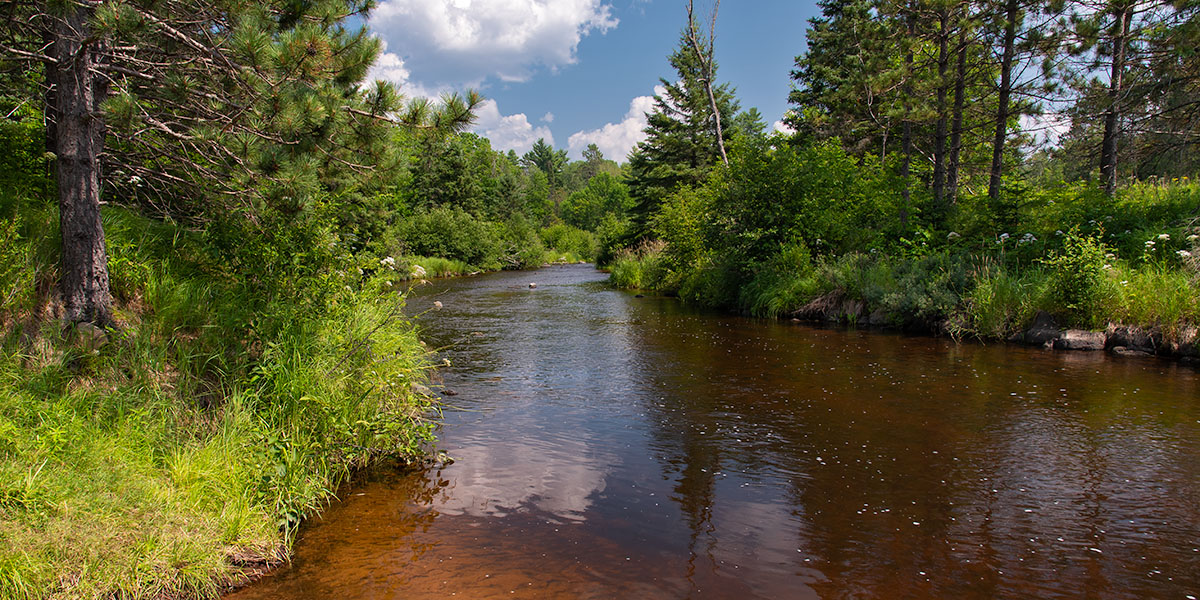Canoe Camping at its Best
The Namekagon is one of Wisconsin's premier flatwater, canoeing and kayaking rivers. The river passes through long stretches of beautiful wilderness scenery, and the national Forest maintains many canoe campsites along its entire length, making the river immensely popular for multi-day paddle trips.
Beginning at Namekagon Lake, the river starts out as a small cold-water trout stream, then meanders narrow and intimate, through a landscape of northern lowland forest, bog-and-fen, and open marsh. Numerous islands populate the river.
Several low-hazard rapids occur through narrow channels below Hayward. Occasionally the river settles into a lake environment, wide and slow, through open wetlands where birdlife is abundant.
The river steadily widens and deepens as it passes Springbrook Landing and is mostly flatwater with occasional riffles throughout this reach. Several road bridges cross over the river as it flows past Trego and enters Trego Lake, a long narrow flowage created by the Trego Lake Dam, which requires a short portage.
Below County K Landing, the river passes through a long stretch of beautiful wilderness of quaking aspen, birch, oak, maple, pines, and spruce all the way to the St Croix River confluence. The forest often canopies high sandy banks on the outside of river-bends. The flow is mostly flatwater with occasional riffles.
Overall, the Namekagon offers a fantastic paddling experience, especially for multi-day excursions!
The river's habitat is home to an abundance of wildlife. Merganser, woodland duck, ruffed grouse, and bald eagle are occasionally spotted. You may also see whitetail deer, black bear, otter, beaver (upper reaches), and if you are lucky, a curious fox. The river's clean waters are home to more than forty different species of mussels. Anglers will find the cooler temperatures of the upper reaches of the Namekagon to be excellent for brook and brown trout. The river also has a population of smallmouth bass.
The Namekagon River was one of the eight original rivers to be designated as a protected area by the National Wild and Scenic Rivers Act of 1968, which made the Namekagon part of the St Croix National Scenic Riverway. Since the enactment, a number of buildings, cottages, homes, and footbridges have been removed from the riverway. The removals are ongoing and are part of voluntary agreements with the National Park Service. Long sections of the river have seen a return to a near-original state, and efforts continue today.
Glass beverage containers are prohibited on the riverway!
The National Park Service operates a Visitor Center in Trego, WI, which is open seven days a week from 9:00 am to 4:30 pm, Memorial Day through Labor Day.
Alert From the National Park Service
Water is no longer available at McDowell Bridge Landing, Riverside Landing, or the Marshland District Office on Highway 70. Please plan accordingly and bring an adequate supply of water.
River Camping
The National Park Service maintains more than sixty individual and group campsites along the riverway. All sites include a clearing for tents (often shaded!), a fire-ring and a rustic toilet (bring toilet paper). Picnic tables are available at most of the campsites. Several of the sites are accessible by car, including: Earl Park, Howell Landing, and West Howell Landing.
Individual sites accommodate up to three tents and/or eight people, while the group sites hold up to six tents and/or sixteen people. There are no fees for accessing, camping, or parking in any of the National Scenic Riverway areas. There is a three night limit of stay. All sites are available on a first-come, first-served basis.
Campgrounds and Lodging
The Hayward Lakes region is one of the premier vacation areas in northern Wisconsin. There are many motels, resorts, and private campgrounds in the area. Visit one of the local chamber websites for more info.
Each segment webpage will have more detailed info about local National Forest, State Park, and County Park campgrounds.
Historical Note
Since the time when Native Americans first settled the region, the Namekagon provided an important segment of the travel and trade routes from northern Wisconsin and the upper Great lakes to the Mississippi River. Besides Native Americans; European explorers, fur traders, and missionaries traveled the river until the eventual arrival of the lumberjacks in the 1800's, when the loggers used the Namekagon to float timber down to the St. Croix and Mississippi Rivers.
Season
The upper reaches (N1) are best in May and June, thereafter following an extended rainfall from July through September. The rest of the river is usually navigable throughout the warm-weather season. Visit each segment's webpage for more specific information
